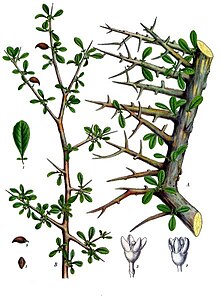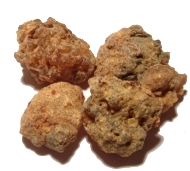Commiphora myrrha
| Commiphora myrrha | |
|---|---|

| |
| Scientific classification | |
| Kingdom: | Plantae |
| Clade: | Tracheophytes |
| Clade: | Angiosperms |
| Clade: | Eudicots |
| Clade: | Rosids |
| Order: | Sapindales |
| Family: | Burseraceae |
| Genus: | Commiphora |
| Species: | C. myrrha
|
| Binomial name | |
| Commiphora myrrha | |
| Synonyms[2] | |
|
List
| |
Commiphora myrrha, called myrrh,[1] African myrrh,[1] herabol myrrh,[1] Somali myrrhor,[1] common myrrh,[3] is a tree in the family Burseraceae. It is one of the primary trees used in the production of myrrh, a resin made from dried tree sap. The tree is native to the Arabian Peninsula (Oman, Yemen) and to Africa (Djibouti, Ethiopia, Somalia, Northeast Kenya).[4] It is called 'mur' (المر) in Arabic, meaning bitter. It famously comes from Mecca, so it is called 'Mur Makki'.[citation needed]
Description
[edit]
Commiphora myrrha is very spiny and it grows to a height of about 5 m (16 ft).[5] Its short, hairless, thick, and flaky trunk has two layers of bark. The upper layer is silvery, whitish, reddish, or bluish-grey and has a papery-texture. Underneath it, the bark is green and performs photosynthesis.
Due to this species' high variability, Commiphora myrrha can be difficult to distinguish from other species within the Commiphora genus.[6] The leaves of Commiphora myrrha are a greyish-green colour with a papery texture.[5] The plant's leaves may come in an oblong or oval shape and are between 6-44mm long, and 3-20mm wide.[5][7] Each leaf alternates and consists of three leaflets in a pinnately compound arrangement.[5]
The plant's yellow-red flowers are dioecious and are arranged in a panicle inflorescence.[5][7] The flowers of the common myrrh are very tiny and are oval shaped. The male flowers are only 3-4mm long and flower early. Its smooth, brown fruit is about the same size as the flowers, and is shaped like an egg.
Resin
[edit]From the stem of Commiphora myrrha, its oleoresin oozes from incisions in the bark and dries into small clumps of sap.[8][9] The resin's fragrance and its medicinal properties come from the various classes of terpenoids it contains.[10] Additionally, the common myrrh tastes sour, bitter, and aromatic.
Distribution and habitat
[edit]Native to eastern and northeastern Africa and the Arabian peninsula, this plant grows on slopes and valleys in desert regions with open Vachellia.[6][7][8] It grows at an elevation of approximately 250 to 1,300 m (820 to 4,270 ft) with a yearly mean rainfall of about 23 to 30 cm (9.1 to 11.8 in). It does best in thin soil, primarily in areas with limestone.[11]

History
[edit]Myrrh extracted from Commiphora myrrha was a precious commodity in the ancient world, as it was used to create perfumes and incense.[8] Myrrh was traditionally used in the ancient world as an insect repellent, incense for religious rituals and in embalming the dead.[7][8] Physicians also took advantage of its medicinal properties, treating it for several ailments, including wounds, diseases such as leprosy and syphilis, and to help with digestion and menstruation.
Medicinal properties
[edit]It is anti-bacterial, anti-fungal, anti-pest and can be used for fumigation or oral use.[10] It has been used as an astringent, antiseptic, anti-parasitic, anti-viral anti-tussive, emmenagogue, and anti-spasmodic agent. It was commonly included in mixtures used to treat worms, wounds, and sepsis. It is also a potent treatment for gingivitis, canker sores, sore throat, boils, arthritis, and acne.[12] Due to its medicinal properties, it is imagined as a potential preventative and therapeutic agent for several diseases, including COVID-19.[10]
Modern uses
[edit]Resin from Commiphora myrrha continues to be an important source of myrrh, which is a key ingredient that adds flavour to meat products, desserts, soft drinks, gum, and sweets.[6] Moreover, its use as a fragrance in incense has extended to other cosmetic products, such as mouthwash,[7] soaps, and perfumes.
References
[edit]- ^ a b c d e "Commiphora myrrha". Germplasm Resources Information Network. Agricultural Research Service, United States Department of Agriculture. Retrieved 2009-01-15.
- ^ "Commiphora myrrha". The Plant List: A Working List of All Plant Species. Retrieved June 6, 2014.
- ^ Kynes S (8 November 2013). Mixing Essential Oils for Magic: Aromatic Alchemy for Personal Blends. Llewellyn Worldwide. pp. 191–. ISBN 978-0-7387-3715-7.
- ^ "Commiphora myrrha". Cactus art: The world of cacti & succulents. Retrieved 2009-01-15.
- ^ a b c d e "Commiphora myrrha". www.cactus-art.biz. Retrieved 2022-12-05.
- ^ a b c "Myrrh - American Botanical Council". www.herbalgram.org. Retrieved 2022-12-05.
- ^ a b c d e "Commiphora myrrha Myrrh, Myrrh Gum PFAF Plant Database". pfaf.org. Retrieved 2022-12-05.
- ^ a b c d "Commiphora myrrha". www.cactus-art.biz. Retrieved 2022-12-05.
- ^ "Myrrh - American Botanical Council". www.herbalgram.org. Retrieved 2022-12-05.
- ^ a b c Batiha GE, Wasef L, Teibo JO, Shaheen HM, Zakariya AM, Akinfe OA, et al. (November 2022). "Commiphora myrrh: a phytochemical and pharmacological update". Naunyn-Schmiedeberg's Archives of Pharmacology. 396 (3): 405–420. doi:10.1007/s00210-022-02325-0. PMC 9672555. PMID 36399185.
- ^ "Commiphora myrrha Species Information". World of Forestry Centre. Archived from the original on 2011-09-30. Retrieved 2009-01-15.
- ^ El Ashry, E. S. H.; Rashed, N.; Salama, O. M.; Saleh, A. (2003-03-01). "Components, therapeutic value and uses of myrrh". Die Pharmazie. 58 (3): 163–168. PMID 12685809.
External links
[edit]- "List of Chemicals Found in Commiphora myrrha". Dr. Duke's Phytochemical and Ethnobotanical Databases. U.S. Department of Agriculture. Archived from the original on 2019-12-22. Retrieved 2018-01-20.
- Committee on Herbal Medicinal Products. "Myrrha". European Medicines Agency.
